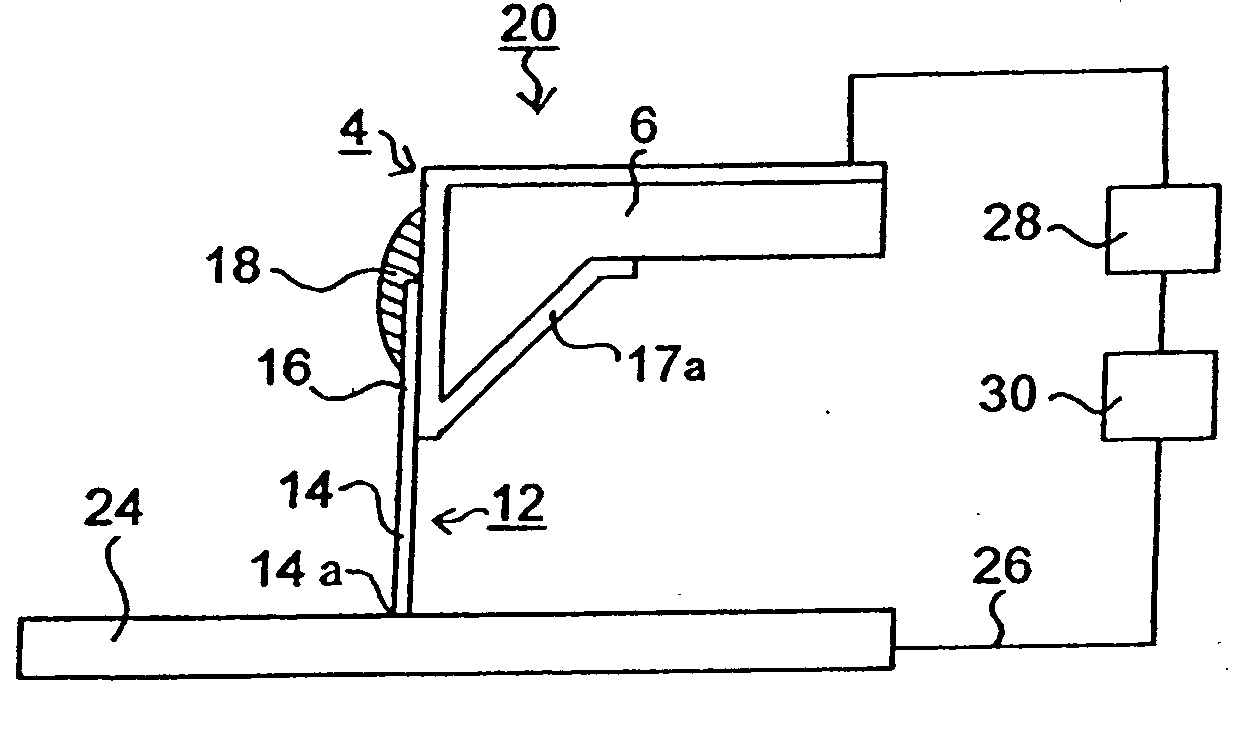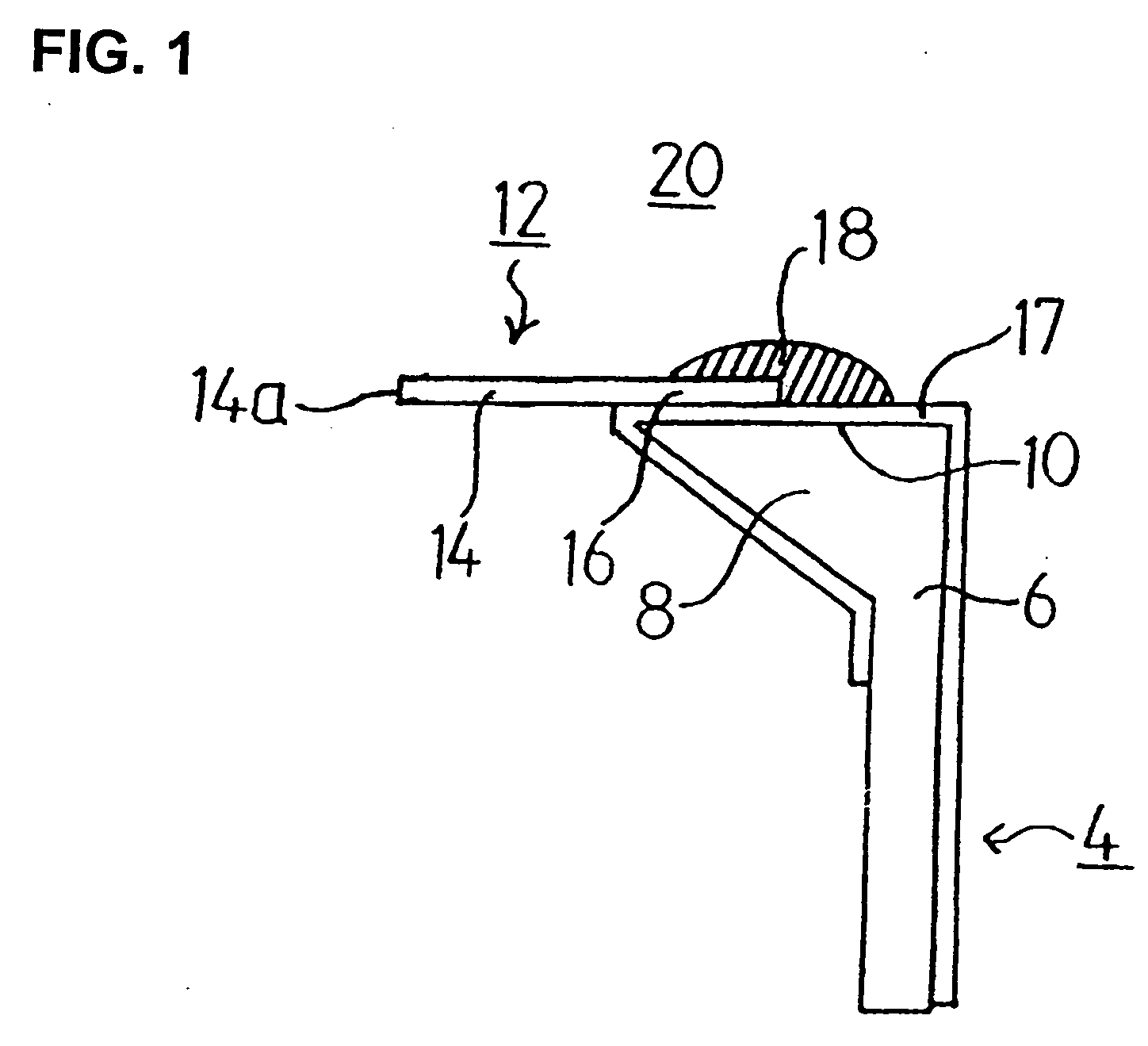Probe for a scanning microscope
a scanning microscope and probe technology, applied in the direction of instruments, mechanical roughness/irregularity measurements, measurement devices, etc., can solve the problem of physical limits to the sharpness of the tip end of the above-described protruding portion, the tendency of the carbon nanotube to fall off the protruding portion, etc., to achieve high sensitivity, high sensitivity, high sensitivity
- Summary
- Abstract
- Description
- Claims
- Application Information
AI Technical Summary
Benefits of technology
Problems solved by technology
Method used
Image
Examples
first embodiment
[0047]FIG. 1 is a schematic explanatory diagram of the scanning microscope probe of the present invention.
[0048] The cantilever 4 is a member that is used as an AFM probe needle; and this cantilever 4 is comprised of a cantilever main portion 6 and a protruding portion 8 that is formed in protruding form on the tip end of the cantilever main portion 6. A palladium covering film 17 which extends from the surface of the cantilever main portion 6 to a specified region on the surface 10 of the protruding portion is formed on the cantilever 4. This palladium covering film 17 is formed from palladium or a palladium alloy and has good conductivity.
[0049] The base end portion 16 of the nanotube 12 is disposed in contact with the surface of the palladium covering film 17 on the surface 10 of the protruding portion 8. The tip end portion 14 of the nanotube 12 protrudes to the outside, and the tip end 14a of the tip end portion 14 constitutes a probe needle tip end for detecting signals. A co...
second embodiment
[0062]FIG. 3 is a schematic explanatory diagram of the scanning microscope probe of the present invention. Parts that are the same as in FIG. 1 are labeled with the same symbols, and a description of such parts is omitted; and only those parts that are different will be described below.
[0063] In this embodiment of FIG. 3, as in FIG. 1, a palladium covering film 17 that extends from the surface of the cantilever main portion 6 to a specified region on the surface 10 of the protruding portion 8 is formed on the cantilever 4. In this embodiment, the nanotube 12 is fastened to the surface 10 of the protruding portion 8 by the above-described second fastening method, i.e., by fusion.
[0064] The physical mechanism of this fastening method using fusion is electric currently unclear; however, the following mechanism may be inferred. For example, as a result of the injection of energy from the outside, the electron state in the base end portion of the nanotube is excited, so that a partial s...
fourth embodiment
[0069]FIG. 5 is a schematic explanatory diagram of the scanning microscope probe of the present invention.
[0070] In this fourth embodiment, the conductive covering film 22 of the third embodiment of FIG. 4A is extended so that this film covers the tip end portion 14 of the nanotube 12. Though not shown in the drawings, the conductive covering film 22 can also be constructed in the same manner in the structure of FIG. 4B. The conductive covering film 22 covers the tip end 22a and imparts the properties of a conductive substance to the probe needle. In cases where the conductive covering film 22 is constructed from ferromagnetic metal atoms such as Fe, Co or Ni, or in cases where this film is constructed from a palladium covering film to which ferromagnetic metal atoms are added, then the nanotube probe needle has the property of detecting the magnetism of the sample. In other words, magnetic images of the sample surface can be acquired.
[0071]FIGS. 6A and 6B are schematic explanatory...
PUM
 Login to View More
Login to View More Abstract
Description
Claims
Application Information
 Login to View More
Login to View More - R&D
- Intellectual Property
- Life Sciences
- Materials
- Tech Scout
- Unparalleled Data Quality
- Higher Quality Content
- 60% Fewer Hallucinations
Browse by: Latest US Patents, China's latest patents, Technical Efficacy Thesaurus, Application Domain, Technology Topic, Popular Technical Reports.
© 2025 PatSnap. All rights reserved.Legal|Privacy policy|Modern Slavery Act Transparency Statement|Sitemap|About US| Contact US: help@patsnap.com



